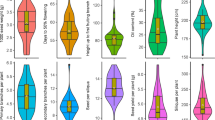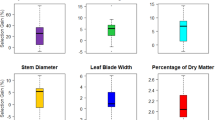Abstract
Large random samples of inbred families extracted from the highly heterotic cross of varieties 2 and 12 of Nicotiana rustica by single seed descent (60 families) and pedigree inbreeding (784 families) have been compared for seven quantitative characters. As expected on theoretical grounds there were no differences in the phenotypic and genotypic properties of the inbred families ascribable to the method used for their extraction. The samples confirmed that inbred families which outperform the heterotic F1 can be readily extracted from it by either method.
The hierarchical structure of the pedigree inbred families allowed a more sophisticated genetical analysis than the simple structure of the single seed descent families. But while the more complex structure allowed the detection of repulsion linkage for five of the seven characters, non-allelic interaction was detected for only one of them. The pedigree inbred families do not, therefore, provide a sensitive test for the non-allelic interactions which are detected by analyses of alternative designs.
Similar content being viewed by others
Article PDF
References
Jinks, J L. 1983. Biometrical genetics of heterosis. In Frankel, R. (ed.) Heterosis, Springer-Verlag, Berlin, pp. 1–46.
Jinks, J L, and Pooni, H S. 1976. Predicting the properties of recombinant inbred lines derived by single seed descent. Heredity, 36, 253–266.
Jinks, J L, and Pooni, H S. 1980. Comparing prediction of mean performance and environmental sensitivity of recombinant inbred lines based upon F3 and triple test cross families. Heredity, 45, 305–312.
Jinks, J L, and Pooni, H S. 1981a. Comparative results of selection in the early and late stages of an inbreeding programme. Heredity, 46, 1–7.
Jinks, J L, and Pooni, H S. 1981b. Properties of pure breeding lines produced by di-haploidy, single seed descent and pedigree breeding. Heredity, 46, 391–395.
Jinks, J L, and Pooni, H S. 1982. Predicting the properties of pure breeding lines extractable from a cross in the presence of linkage. Heredity, 49, 265–270.
Kearsey, M J, and Jinks, J L. 1968. A general method of detecting additive, dominance and epistatic variation for metrical traits. I. Theory. Heredity, 23, 403–409.
Mather, K, and Jinks, J L. 1982. Biometrical Genetics. 3rd edn. Chapman and Hall, London.
Pooni, H S, and Jinks, J L. 1978. Predicting the properties of recombinant inbred lines derived by single seed descent for two or more characters simultaneously. Heredity, 40, 349–361.
Pooni, H S, and Jinks, J L. 1979. Sources and biases of the predictors of recombinant inbreds derived by single seed descent. Heredity, 42, 41–48.
Pooni, H S, and Jinks, J L. 1981a. Sources of predictions and their reliability in predicting the properties of recombinant inbred lines which can be obtained from a cross by single seed descent. Proceedings of the Fourth International Barley Genetics Symposium, Edinburgh, Scotland, pp. 73–78.
Pooni, H S, and Jinks, J L. 1981b. The true nature of the non-allelic interactions in Nicotiana rustica revealed by association crosses. Heredity, 47, 253–258.
Pooni, H S, and Jinks, J L. 1982. Comparative analysis of association and dispersion crosses to detect linkage and epistatic components of variation. Heredity, 49, 211–220.
Pooni, H S, and Jinks, J L. 1983a. Comparison of associated and dispersed testers in the triple test cross. Heredity 50, 73–83.
Pooni, H S, and Jinks, J L. 1983b. Joint analysis of triple test crosses of a single population with associated and dispersed inbred testers. Heredity, 50, 311–320.
Pooni, H S, Jinks, J L, and Jayasekara, N E M. 1978. An investigation of gene action and genotype × environment interaction in two crosses of Nicotiana rustica by triple test cross and inbred line analysis. Heredity, 41, 83–92.
Pooni, H S, Jinks, J L, and Pooni, G S. 1978. A general method for detection and estimation of additive, dominance and epistatic variation for metrical traits. IV. Triple test cross analysis for normal families and their selfs. Heredity, 44, 177–192.
Author information
Authors and Affiliations
Rights and permissions
About this article
Cite this article
Jinks, J., Pooni, H. Comparison of inbred lines produced by single seed descent and pedigree inbreeding. Heredity 53, 299–308 (1984). https://doi.org/10.1038/hdy.1984.89
Received:
Issue date:
DOI: https://doi.org/10.1038/hdy.1984.89
This article is cited by
-
Comparison of pedigree selection and single seed descent for oil yield in linseed (Linum usitatissimum L.)
Euphytica (1995)
-
Expectation of means and variances of testcrosses produced from from F2 and backcross individuals and their selfed progenies
Heredity (1987)
-
Estimation of the true additive genetic variance ∑ i = 1 k d i 2 in the presence of linkage disequilibrium
Heredity (1986)
-
Comparison of inbred lines extracted from two single crosses and their double cross by single seed descent
Heredity (1986)
-
Predicting and observing the properties of second cycle hybrids using basic generations and inbred line × F1 crosses
Heredity (1985)



